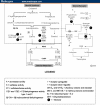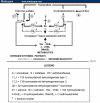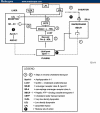Postmenopausal tibolone therapy: biologic principles and applied clinical practice
- PMID: 17435612
- PMCID: PMC1924982
Postmenopausal tibolone therapy: biologic principles and applied clinical practice
Abstract
Although the menopause is a generic physiologic event, its biology is variable and specific to a given individual. Genetically determined distribution and polymorphism of relevant hormone receptors, enzymes, and various cofactors are the biologic mechanisms controlling an individual's clinical response to endogenous and prescribed hormones. Advances in molecular biology have led to the development of newer pharmacologic agents that are tailored to meet specific therapeutic objectives, based on the hormonal biology of relevant organs. Tibolone, an analogue of the progestin, norethynodrel, is a drug with tissue-specific effects on receptors and enzymes that influences the synthesis and metabolism of endogenous estrogen, progesterone, and androgen. This is achieved via the intestinal bioconversion of tibolone into metabolites that have tissue-specific agonistic and/or antagonistic estrogenic (3alpha and 3beta hydroxytibolone) and progestogenic/androgenic (delta4 tibolone) properties. The postmenopausal synthesis and metabolism of estrogen and androgen are briefly reviewed with particular reference to sex steroid activity in various target organs. On the basis of this hormonal physiology, the clinical utility of tibolone is reviewed as a therapeutic agent for the treatment of the symptomatic menopause. The effects of tibolone on bone health and osteoporosis, cardiovascular disease, the breast, and the endometrium are summarized, and its role in clinical practice is reviewed.
Figures




Similar articles
-
Tibolone: the way to beat many a postmenopausal ailments.Expert Opin Pharmacother. 2008 Apr;9(6):1039-47. doi: 10.1517/14656566.9.6.1039. Expert Opin Pharmacother. 2008. PMID: 18377345 Review.
-
Spanish Menopause Society position statement: use of tibolone in postmenopausal women.Menopause. 2013 Jul;20(7):754-60. doi: 10.1097/GME.0b013e31827b18c5. Menopause. 2013. PMID: 23793166
-
Effects of tibolone on the breast of postmenopausal women.Taiwan J Obstet Gynecol. 2007 Jun;46(2):121-6. doi: 10.1016/S1028-4559(07)60005-9. Taiwan J Obstet Gynecol. 2007. PMID: 17638619 Review.
-
Tibolone and its metabolites enhance tissue factor and PAI-1 expression in human endometrial stromal cells: Evidence of progestogenic effects.Steroids. 2005 Nov;70(12):840-5. doi: 10.1016/j.steroids.2005.04.010. Steroids. 2005. PMID: 16011840
-
[Postmenopausal hormonal treatment: conventional hormone replacement therapy or tibolone? Effects on bone].J Gynecol Obstet Biol Reprod (Paris). 2002 Oct;31(6):541-9. J Gynecol Obstet Biol Reprod (Paris). 2002. PMID: 12407324 Review. French.
Cited by
-
Anabasis setifera leaf extract from arid habitat: A treasure trove of bioactive phytochemicals with potent antimicrobial, anticancer, and antioxidant properties.PLoS One. 2024 Oct 25;19(10):e0310298. doi: 10.1371/journal.pone.0310298. eCollection 2024. PLoS One. 2024. PMID: 39453934 Free PMC article.
-
Oral Therapeutics Post Menopausal Osteoporosis.Cureus. 2023 Aug 2;15(8):e42870. doi: 10.7759/cureus.42870. eCollection 2023 Aug. Cureus. 2023. PMID: 37664395 Free PMC article. Review.
-
Effect of prolonged use of high dose of tibolone on the vagina of ovariectomized rats.Int J Exp Pathol. 2011 Aug;92(4):266-71. doi: 10.1111/j.1365-2613.2011.00774.x. Epub 2011 Apr 26. Int J Exp Pathol. 2011. PMID: 21518049 Free PMC article.
-
Effects of Tibolone on the Central Nervous System: Clinical and Experimental Approaches.Biomed Res Int. 2017;2017:8630764. doi: 10.1155/2017/8630764. Epub 2017 Jan 16. Biomed Res Int. 2017. PMID: 28191467 Free PMC article. Review.
-
Genistein administered as a once-daily oral supplement had no beneficial effect on the tibia in rat models for postmenopausal bone loss.Menopause. 2013 Jun;20(6):677-86. doi: 10.1097/gme.0b013e31827d44df. Menopause. 2013. PMID: 23385720 Free PMC article.
References
-
- Writing group for the Women's Health Initiative investigators. Risks and benefits of estrogen plus progestin in healthy postmenopausal women: principal results from the Women's Health Initiative randomized controlled trial. JAMA. 2002;288:321–333. - PubMed
-
- Notelovitz M. The clinical practice impact of the Women's Health Initiative: political vs biological correctness. Maturitas. 2003;44:3–9. - PubMed
-
- Riggs BK, Hartmann LC. Selective estrogen receptor modulators – mechanism of action and application to clinical practice. N Engl J Med. 2003;345:618–629. - PubMed
-
- Chetrite GS, Pasqualini JR. The selective estrogen enzyme modulator (SEEM) in breast cancer. J Steroid Biochem Mol Biol. 2001;76:95–104. - PubMed
-
- Kloosterboer HJ. Tibolone: a steroid with a tissue-specific mode of action. J Steroid Biochem Mol Biol. 2001;70:231–238. - PubMed
Publication types
MeSH terms
Substances
LinkOut - more resources
Full Text Sources

